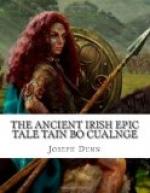And for thy manhood’s sake, young warrior, pray
come to my aid, so that that famous Cuchulain come
not upon me.” “Take thy choice, gilla,”
said Cuchulain, “to gather or to trim them,
either.” “I will see to gathering
them, for it is easier,” [2]the gilla answered.[2]
Cuchulain started to cut the poles and he drew them
between the forks of his feet and his hands against
their bends and their knots, so that he made them
smooth and straight and slippery and trimmed; he polished
them so that not even a midge could find footing thereon
when he had passed them away from him. Then full
sure the gilla gazed upon him. “Far then,
meseems, from fitting is the task I put on thee. [3]And
for love of thy valour,[3] who art thou, say, O warrior?”
the gilla asked, [4]for he was sore affrighted.[4]
“That same renowned Cuchulain am I of whom thou
spakest [5]a while ago[5] in the morning.”
“Woe is me then, by reason of this,” cried
the gilla; “for this am I lost forever.”
[LL.fo.68b.] [6]"Whence comest thou [7]and who art
thou[7]?” Cuchulain asked. “Charioteer
am I of Orlam, Ailill’s son and Medb’s,"[6]
[8]said he.[8] [9]"Fear nothing;[9] I will not slay
thee at all, boy,” said Cuchulain; “for
I slay nor charioteers nor horseboys nor persons unarmed.
But, prithee, where is thy master, [10]gilla[10]?”
“Over yonder by the trench, [11]with his back
to the pillar-stone,[11]” answered the gilla.
“Off with thee thither to him and bear him a
warning that he be on his guard. For if we meet
he shall fall by my hand.”
[4-4] H. 2. 17.
[5-5] H. 2. 17.
[6-6] H. 2. 17.
[7-7] Stowe.
[1-1] LU. and YBL. 777.
[2-2] Stowe.
[3-3] H. 2. 17.
[4-4] LU. and YBL. 786
[5-5] H. 2. 17.
[6-6] LU. and YBL. 786-787.
[7-7] H. 2. 17.
[8-8] LU. 787.
[9-9] LU. and YBL. 789.
[10-10] H. 2. 17.
[11-11] H. 2. 17.
[W.1419.] Thereupon the charioteer repaired [1]by
one way[1] to his master, [2]and Cuchulain went by
another,[2] and fast as the gilla sped to Orlam, faster
still Cuchulain did reach him [3]and offered him combat[3]
and he struck off his head, and raising it aloft displayed
it to the men of Erin, [4]and he flourished it in
the presence of the host.[4] [5]Then he put the head
on the charioteer’s back and said, “Take
this with thee, and so go to the camp. Unless
thou goest so, a stone out of my sling will reach thee.”
[1-1] H. 2. 17.
[2-2] H. 2. 17.
[3-3] H. 2. 17.
[4-4] Stowe, LU. and YBL.
792.
When the charioteer came nigh to the camp he took
the head from his back and told his adventures to
Ailill and Medb. “It is not the same, this
exploit and the catching of birds,” quoth she.
“And he told me” (said the boy), “unless
I brought it on my back to the camp, he would break
my head with a stone."[5] [6]Hence Leaca Orlaim (’Orlam’s
Flagstones’) to the north of Disert Lochaid
is the name of the place where he fell. Tamlachta
(’Gravestones’) is another name for it,
and it is for this reason it is so called because
of the little gravestones and the violent deaths which
Cuchulain worked on it."[6]




